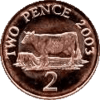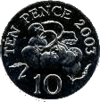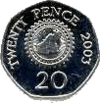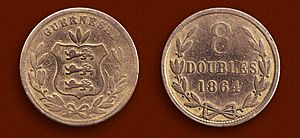Guernsey pound facts for kids
Quick facts for kids Guernsey pound |
|
|---|---|
| ISO 4217 Code | none |
| User(s) | |
| Inflation | 1.9% |
| Source | States of Guernsey, March 2018 |
| Pegged with | variant of pound sterling |
| Subunit | |
| 1⁄100 | penny |
| Symbol | £ |
| penny | p |
| Plural | |
| penny | pence |
| Coins | 1p, 2p, 5p, 10p, 20p, 50p, £2 |
| Banknotes | £1, £5, £10, £20, £50 |
The Guernsey pound is the money used in Guernsey, a small island in the English Channel. It's not a completely separate currency. Instead, it's like a special local version of the pound sterling used in the United Kingdom.
This means that Guernsey banknotes and coins have the same value as UK money. You can usually use them interchangeably. Think of it like how different banks in Scotland or Northern Ireland issue their own versions of the pound, but they are all worth the same.
Because it's so closely linked to the UK pound, there isn't a special international code for the Guernsey pound. But sometimes, people use "GGP" to show they are talking about Guernsey's money.
Contents
History of Guernsey's Money
For a long time, Guernsey used mostly French money.
- Before 1834, they used coins from the French livre.
- Then, until 1921, they used French francs.
Early Guernsey Coins: The Double
In 1830, Guernsey started making its own copper coins called doubles.
- A double was worth a tiny part of a French franc.
- The name "double" came from "double deniers", which was an old French coin.
- They made coins in values of 1, 2, 4, and 8 doubles.
- The 8-double coin was called a "Guernsey penny". Twelve of these made a "Guernsey shilling".
- However, this Guernsey shilling was not worth the same as a British shilling.
Pounds and Francs Circulate Together
The States of Guernsey (the island's government) also started printing banknotes in pounds from 1827.
- In 1848, a rule was made that the British pound sterling should be accepted as money.
- But this rule was cancelled two years later. French money, along with the local Guernsey coins and notes, continued to be used.
- In 1870, British coins officially became legal money in Guernsey.
- Bank of England notes were also accepted from 1873.
- In 1914, new Guernsey banknotes came out. Some of these showed values in both Guernsey shillings and francs.
Switching to the British Pound
After World War I, the value of the French franc started to drop compared to the British pound.
- Because of this, Guernsey decided in 1921 to use a pound that was exactly equal to the British pound sterling.
- For small amounts (less than 1 shilling), 1 Guernsey penny (8 doubles) was made equal to 1 British penny. This meant the old Guernsey coins could still be used.
- For larger amounts, 21 Guernsey shillings were made equal to one pound sterling.
- Banknotes from World War I were stamped with the word "British" to show this change.
- New banknotes and British silver coins were used alongside the double coins.
- Special 3-pence coins were even made for Guernsey starting in 1956.
Decimalisation in Guernsey
In 1971, just like the rest of the British Isles, Guernsey changed its money system to decimalisation.
- This meant that one pound was now divided into 100 pence.
- Guernsey then started making a full set of new coins, from 1⁄2p (half penny) up to 50p. Later, £1 and £2 coins were also introduced.
What is Legal Tender?
"Legal tender" means money that must be accepted when paying a debt.
- The Guernsey pound is legal tender only in the Bailiwick of Guernsey.
- However, it is also commonly used in Jersey, another Channel Island.
- In the United Kingdom, shops and businesses don't have to accept Guernsey pounds, but banks and money exchange places can usually swap them for you.
- Other types of notes (like those from the Bank of England, Scotland, the Isle of Man, and Northern Ireland) can also be used in Guernsey.
About £51 million worth of coins and notes are currently being used in Guernsey.
Guernsey Coins
From 1830 to 1956, Guernsey's four main coin values (1, 2, 4, and 8 doubles) looked very similar.
- They had the island's coat of arms and name ("Guernesey") on one side.
- On the other side, they showed the coin's value and the date.
- The 8-double coins also had a wreath design.
New Designs and Decimal Coins
In 1956, new designs were made for the 4 and 8 doubles.
- These coins showed the island's seal and name in Latin on one side.
- The other side had the English name, the date, and the Guernsey lily.
- Threepence coins were also made from 1956, featuring the Guernsey cow.
When Guernsey decimalised in 1971, they introduced new coins: 1⁄2, 1, and 2 new pence.
- These coins were the same size and made of the same materials as British coins.
- The word "new" was removed from the coins in 1977.
Modern Coins
- A £1 coin was introduced in 1981, two years before the UK got its own £1 coin.
- The 20 pence and £2 coins were introduced at the same time as in the UK (1982 and 1998).
- The old round £1 coin stopped being legal tender on 15 October 2017. Now, only the new twelve-sided £1 coin (like the one in the UK) is legal tender on the island.
The first decimal coins had the same design as the last pre-decimal ones until 1985.
- In 1985, a portrait of Queen Elizabeth II by Raphael Maklouf was added.
- Since 1998, a different portrait of the Queen by Ian Rank-Broadley has been used.
Here are the designs you can find on the back of Guernsey's decimal coins:
| Value | 1968–1984 | 1985–present |
|---|---|---|
| 1⁄2p | Numeral | N/A |
| 1p | Gannet | Crab |
| 2p | Windmill | Guernsey cows |
| 5p | Guernsey lily | Yachts |
| 10p | Guernsey cow | Tomatoes |
| 20p | Guernsey milk can | Cog and map |
| 50p | Duke of Normandy's cap | Guernsey freesia |
| £2 | N/A | Flag |
| £0.01 | £0.02 | £0.05 |
|---|---|---|
 |
 |
 |
| Crab | Guernsey cow | Yacht |
| £0.10 | £0.20 | £0.50 |
 |
 |
 |
| Tomato | Depiction of light industry /Map of Guernsey |
Guernsey Freesias |
| £2.00 | ||
 |
||
| Flag of Guernsey motif |
Guernsey Banknotes
In 1827, the States of Guernsey started printing one-pound notes.
- Two private banks, the Guernsey Banking Company and the Guernsey Commercial Banking Company, also issued one-pound notes later on.
- These private banks stopped issuing notes in 1914, but their notes were used until 1924.
- Also in 1914, the States introduced five- and ten-shilling notes. These notes also showed their value in francs.
Changes After World War I
In 1921, the States' notes were stamped with "British". This showed that Guernsey had switched to a pound equal to the British pound.
- From 1924, ten-shilling notes were printed without any mention of the franc.
- The five-shilling note was stopped.
Banknotes During German Occupation
During the German occupation of the Channel Islands in 1941, special notes were printed.
- These notes were in unusual values like 6 pence, 1 shilling 3 pence, 2 shillings 6 pence, and 5 shillings.
- They were printed on special watermarked paper.
- After the island was freed in 1945, £5 notes were introduced. All the smaller notes (below 10 shillings) stopped being made.
Modern Banknotes
- The 10-shilling note was replaced by the 50-new-pence coin before decimalisation.
- £10 notes were introduced in 1975, followed by £20 notes in 1980, and £50 notes in 1994.
- Even though £1 and £2 coins exist, the £1 banknote is still used in Guernsey.
Special Commemorative Banknotes
Guernsey has also issued special banknotes to celebrate important events:
- A commemorative £20 note was issued in 2012 for the Diamond Jubilee of Queen Elizabeth II. It looked similar to the regular £20 note but had special markings.
- A special £1 note was issued on 4 July 2013. This marked 200 years since Thomas De La Rue started his printing business. This note features a portrait of De La Rue.
- On 8 November 2018, another commemorative £20 banknote was issued. This one marked 100 years since the end of World War I. It features poppy flowers.
In 2023, Guernsey announced that future banknotes will include new security features to make them harder to copy.
| Circulating banknotes "Elizabeth II" Issue | ||||||
|---|---|---|---|---|---|---|
| Image | Denomination | Dimensions | Dominant colour | Description | ||
| Obverse | Reverse | Obverse | Reverse | |||
| £1 | 128 × 65 mm | Green | The Market, St Peter Port | Daniel De Lisle Brock, Bailiff of Guernsey 1762–1842, The Royal Court, St Peter Port, 1840 |
||
| £1 Commemorative | 128 × 65 mm | Green | The Market, St Peter Port | Fountain Street (St. Peter Port) Thomas de la Rue, Newspaper ("Le Miroir Politique") |
||
| £5 | 137 × 70 mm | Pink | Queen Elizabeth II, The Town Church |
Fort Grey, Hanois lighthouse 1862 |
||
| £10 | 142 × 75 mm | Blue/orange | Queen Elizabeth II, Elizabeth College |
Saumarez Park, Les Niaux Watermill, Le Trépid Dolmen |
||
| £20 | 150 × 80 mm | Pink | Queen Elizabeth II, St James Concert Hall |
Vale Castle, St Sampson's Church |
||
| £50 | 156 × 85 mm | Brown | Queen Elizabeth II, Royal Court House |
Point de la Mare, La Gran'mère, letter of marque, St Andrew's Church |
||
| Current GBP exchange rates | |
|---|---|
| From Google Finance: | AUD CAD CHF EUR HKD JPY USD JPY USD |
| From Yahoo! Finance: | AUD CAD CHF EUR HKD JPY USD JPY USD |
| From XE.com: | AUD CAD CHF EUR HKD JPY USD JPY USD |
| From OANDA: | AUD CAD CHF EUR HKD JPY USD JPY USD |
| From fxtop.com: | AUD CAD CHF EUR HKD JPY USD JPY USD |
See also


